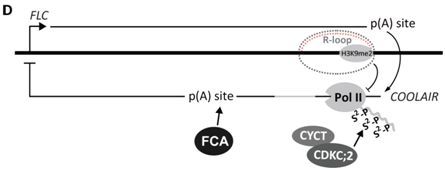
The P-TEFb Transcription Elongation Factor Plays an Indispensible Role in Antisense-mediated FLC Transcriptional Repression
May 13, 2014 Email"> PrintText Size

Long non-coding RNAs (lncRNAs) are tentatively defined as ncRNAs of more than two hundred nucleotides in length. The next generation sequencing methodology has identified pervasive lncRNAs in many genomes, but the mechanisms linking lncRNAs and functional gene expression in higher eukaryotes are still poorly understood.
Dr. WANG Zhiwei from Wuhan Botanical Garden, and Prof. DEAN Caroline from John Innes Centre, UK, studied a role for the cyclin-dependent kinase CDKC;2 in a chromatin-based mechanism repressing the Arabidopsis floral repressor FLC expression.
Through a suppressor mutagenesis screen, CDKC;2, the Arabidopsis CDK component of P-TEFb (the positive transcription elongation factor b), was identified to involve antisense-mediated repression of FLC transcription. The previous work from the Dean’s lab has demonstrated a role of COOLAIR in FLC regulation. The present data suggested that CDKC;2 was required for efficient transcription from the COOLAIR promoter. Further work showed that CDKC;2 did not affect an FLC transgene missing the COOLAIR promoter. This study reveals that tight interconnection between sense and antisense transcription and differential promoter sensitivity to P-TEFb could have a widespread role in quantitative gene regulation.
Relevant results were published in Proceedings of the National Academy of Sciences of the United States of America (PNAS) (doi:10.1073/pnas.1406635111) entitled "Antisense-mediated FLC transcriptional repression requires the P-TEFb transcription elongation factor”. This work was supported by United Kingdom (UK) Biotechnology and Biological Sciences Research Council (BBSRC) Institute Strategic Programme Grant BB/J004588/1 (to the John Innes Centre), UK BBSRC Grant BB/D010799/1 (to C.D.), and a European Research Council Advanced Investigator grant (ENVGENE) (to C.D.).

Working model for how CDKC;2 functions in the FLC sense-antisense transcriptional circuitry (Image by WBG)
Long non-coding RNAs (lncRNAs) are tentatively defined as ncRNAs of more than two hundred nucleotides in length. The next generation sequencing methodology has identified pervasive lncRNAs in many genomes, but the mechanisms linking lncRNAs and functional gene expression in higher eukaryotes are still poorly understood.
Dr. WANG Zhiwei from Wuhan Botanical Garden, and Prof. DEAN Caroline from John Innes Centre, UK, studied a role for the cyclin-dependent kinase CDKC;2 in a chromatin-based mechanism repressing the Arabidopsis floral repressor FLC expression.
Through a suppressor mutagenesis screen, CDKC;2, the Arabidopsis CDK component of P-TEFb (the positive transcription elongation factor b), was identified to involve antisense-mediated repression of FLC transcription. The previous work from the Dean’s lab has demonstrated a role of COOLAIR in FLC regulation. The present data suggested that CDKC;2 was required for efficient transcription from the COOLAIR promoter. Further work showed that CDKC;2 did not affect an FLC transgene missing the COOLAIR promoter. This study reveals that tight interconnection between sense and antisense transcription and differential promoter sensitivity to P-TEFb could have a widespread role in quantitative gene regulation.
Relevant results were published in Proceedings of the National Academy of Sciences of the United States of America (PNAS) (doi:10.1073/pnas.1406635111) entitled "Antisense-mediated FLC transcriptional repression requires the P-TEFb transcription elongation factor”. This work was supported by United Kingdom (UK) Biotechnology and Biological Sciences Research Council (BBSRC) Institute Strategic Programme Grant BB/J004588/1 (to the John Innes Centre), UK BBSRC Grant BB/D010799/1 (to C.D.), and a European Research Council Advanced Investigator grant (ENVGENE) (to C.D.).

Working model for how CDKC;2 functions in the FLC sense-antisense transcriptional circuitry (Image by WBG)
CAS Institutes
There are 124 Institutions directly under the CAS by the end of 2012, with 104 research institutes, five universities & supporting organizations, 12 management organizations that consist of the headquarters and branches, and three other units. Moreover, there are 25 legal entities affiliated and 22 CAS invested holding enterprisesThere are 124 I...>> more
Contact Us

Chinese Academy of Sciences
Add: 52 Sanlihe Rd., Xicheng District, Beijing, China
Postcode: 100864
Tel: 86-10-68597592 (day) 86-10-68597289 (night)
Fax: 86-10-68511095 (day) 86-10-68512458 (night)
E-mail: cas_en@cas.cn

